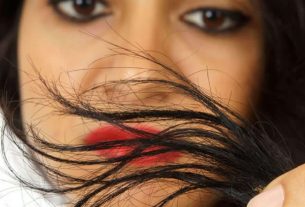Master the Art of Contouring: A Complete Guide for Every Face Shape
Contouring is a technique that has revolutionized the beauty industry, helping people to enhance their natural features and create a more defined, sculpted look. However, what many people don’t realize is that not all face shapes are the same, and contouring techniques should be customized accordingly. Whether you have a round face, oval face, square jawline, or heart-shaped features, there’s a specific way to contour that will help you accentuate your best features.
In this article, I’m going to walk you through everything you need to know about contouring, from what contouring is to how to apply it based on your unique face shape. By the end of this guide, you’ll have a step-by-step process for creating a flawless, chiseled look that enhances your natural beauty and highlights your best features.
So, let’s dive right into the world of contouring!
What is Contouring?
Contouring is the art of using makeup, typically a combination of darker and lighter shades, to define and shape the face. The technique involves highlighting the high points of the face, such as the cheekbones, nose bridge, and brow bone, while adding shadow to areas you want to recede, like the jawline, temples, and sides of the nose.
Contouring is often confused with bronzing, but while both techniques use darker shades, bronzing adds warmth to the skin, giving it a sun-kissed appearance, whereas contouring is more about shaping and defining.
Contouring can be done with cream, powder, or stick formulas, depending on your skin type and personal preference. When done correctly, contouring enhances your features, making them look more sculpted, youthful, and balanced.
How to Contour for Different Face Shapes
Every face shape is unique, and while contouring is universal, the techniques you use should vary depending on the structure of your face. Below, I’ll explain how to contour for each face shape, with tips and tricks that will work for you, no matter your face type.
1. Round Face
A round face typically has full cheeks and a soft jawline, with equal width and length. The goal of contouring a round face is to add structure and definition, creating the illusion of more angles.
How to Contour:
- Cheeks: To make your face appear slimmer, apply a contour shade just below your cheekbones and blend upward, towards your temples. This will create the illusion of high, chiseled cheekbones.
- Jawline: Add contour along the sides of your jawline to slim down the lower part of your face. Blend well to avoid harsh lines.
- Forehead: If you have a broad forehead, you can contour along the hairline to make it appear narrower. Focus the contour on the outer edges of your forehead, blending it well into the temples.
- Nose: For a slimmer nose, apply a thin line of contour along the sides of your nose and blend towards the center. You can also add a bit of highlight down the center of the nose to create the illusion of height.
Why it works: By adding contour to the outer edges of your face and highlighting the center, you create shadows and light that make your face appear more oval and structured.
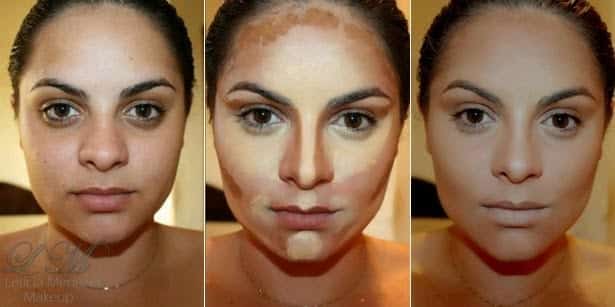
Find out how to identify your face type in our article: What is your face shape? Can you identify?
How to contour for each face type
Rounded faces
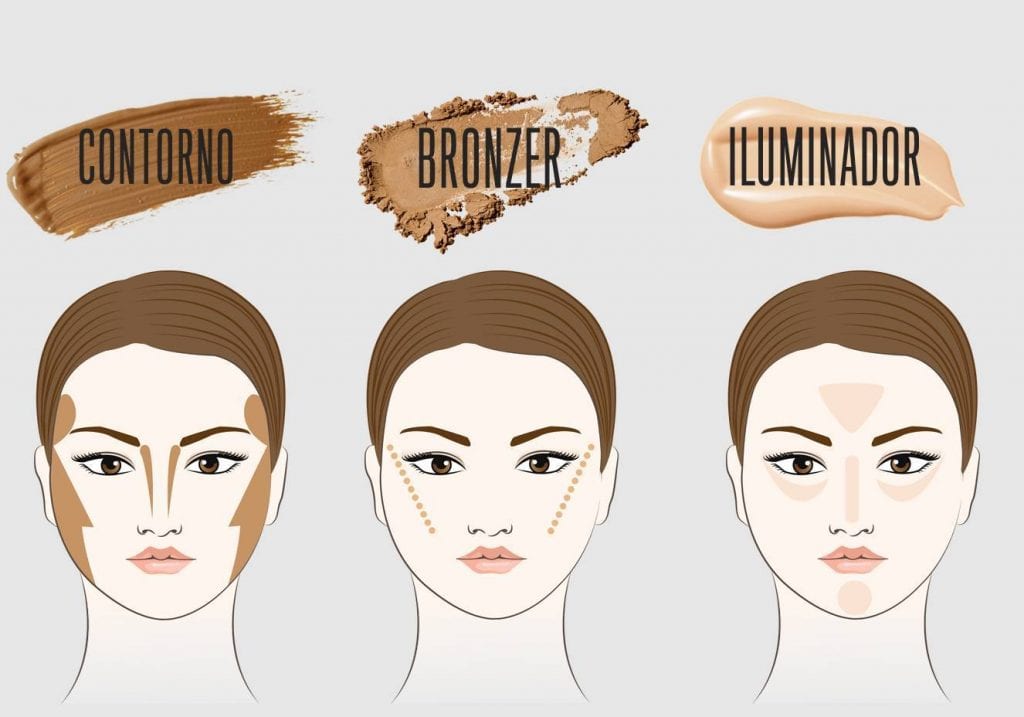
As it does not have well-defined angles, contouring aims to increase the ‘height’ of the face. Making it appear longer.
To achieve this effect, darken the entire side of the face and only lighten the central axis.
Learn how to choose the right bangs for your face type
Inverted triangle or heart faces
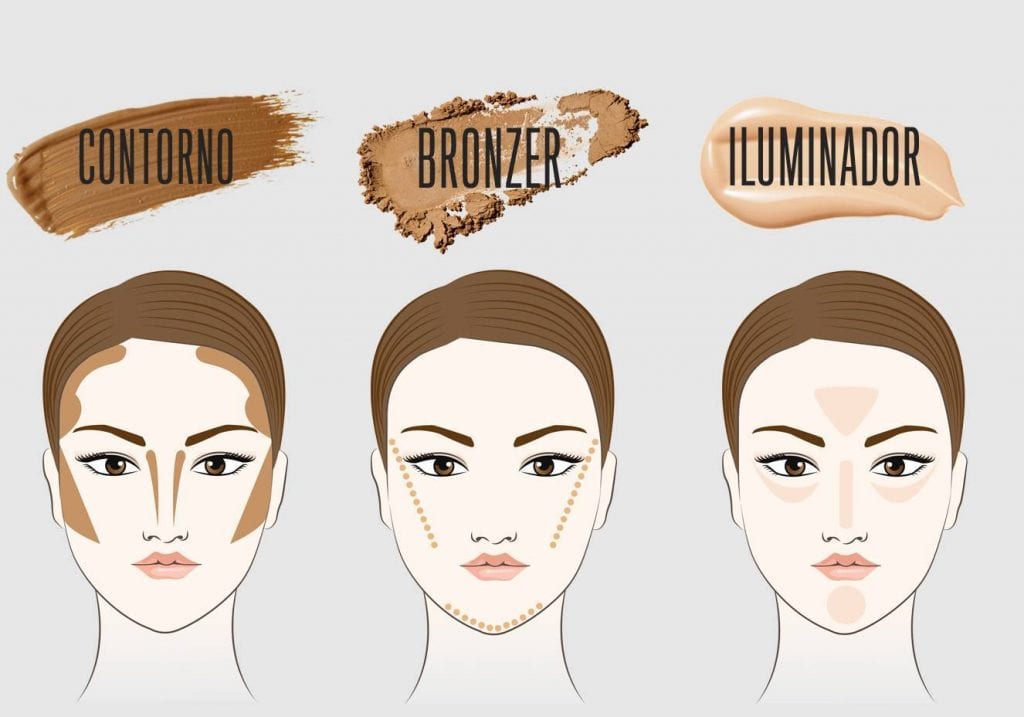
In this type of face, the forehead line is wider than the chin, which is generally more elongated.
To get the contour right, smooth out the difference between the top part – which is wider – and the bottom part – which is thinner.
Use concealer to darken the sides of your forehead and jawline. While applying the highlighter to the “T” zone.
essential tips to start taking care of your face right now
Triangular faces
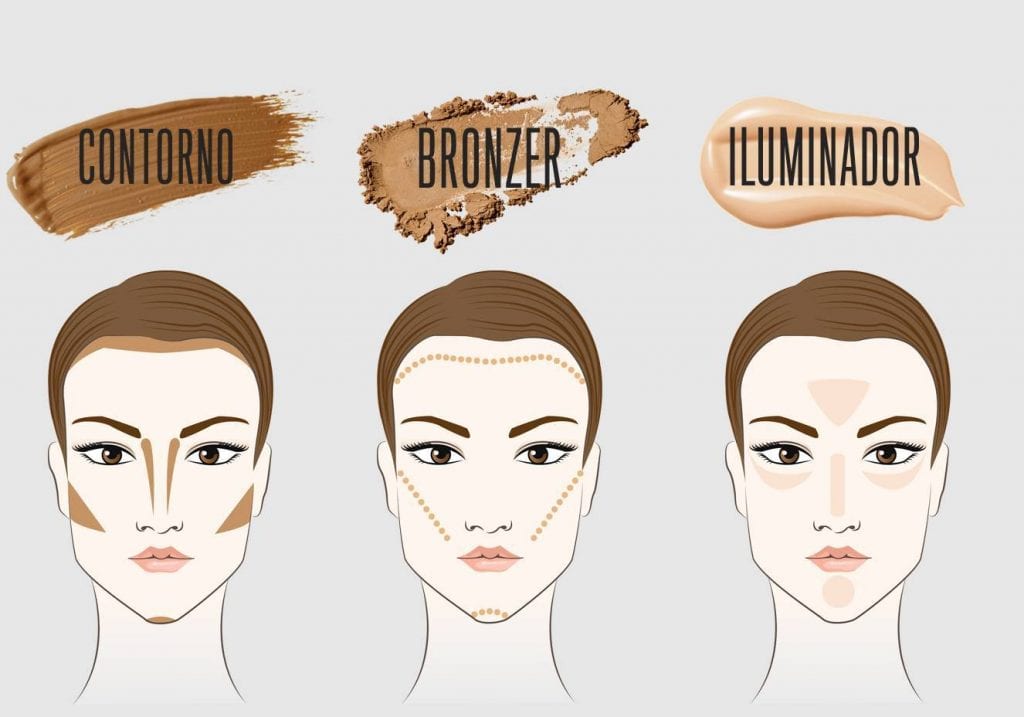
Here the top is narrower. Widening at the jawline. Making this part of the face stand out.
To mitigate this difference, you need to draw attention to the lip line. Then, darken the sides of the jaw with the darker concealer.
And highlight the forehead area, under the eyes and chin for special attention.
How to harmonize the shape of your eyebrows with the shape of your face
Square faces
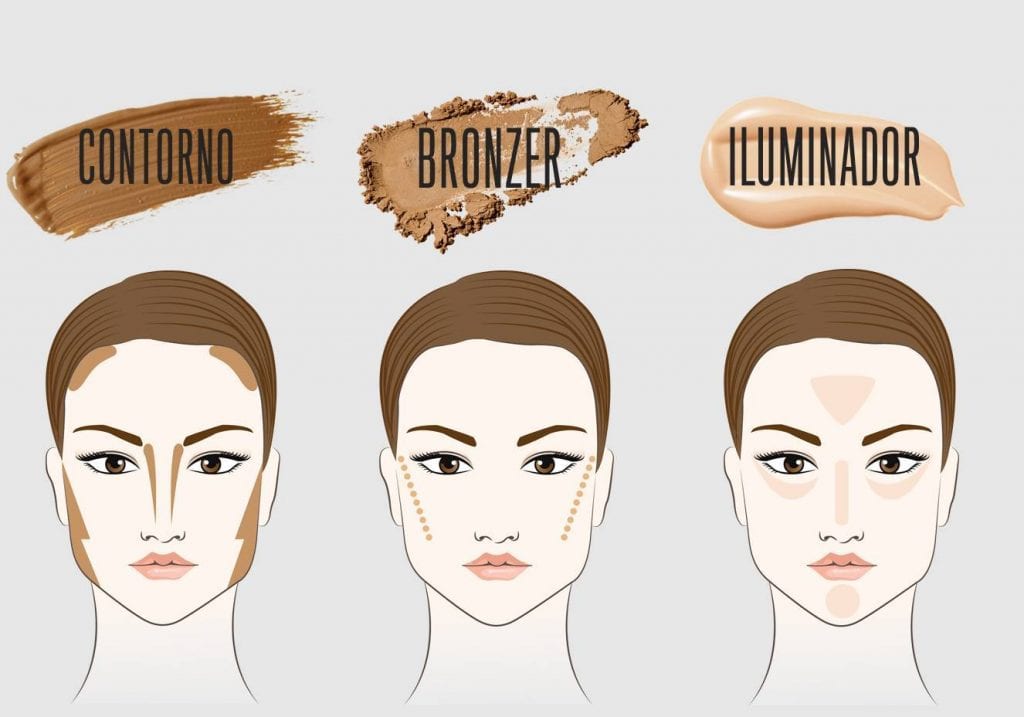
This type of face is easily identified by its wider and stronger physiognomy. The jaw is wide and the features are striking.
Furthermore, there are two very common types, which is the widest, giving a completely square appearance. And the sharpest ones, which resemble a rectangle.
To contour this type of face, soften the straighter, more angular lines. This will create a lighter, more delicate appearance. Use dark concealer to contour the sides of your forehead and jawline.
As for the highlighter, use it in the center of the forehead and chin, in addition to the top of the nose.
Youtuber uses a condom to apply foundation to his face. See how it turned out
oval faces
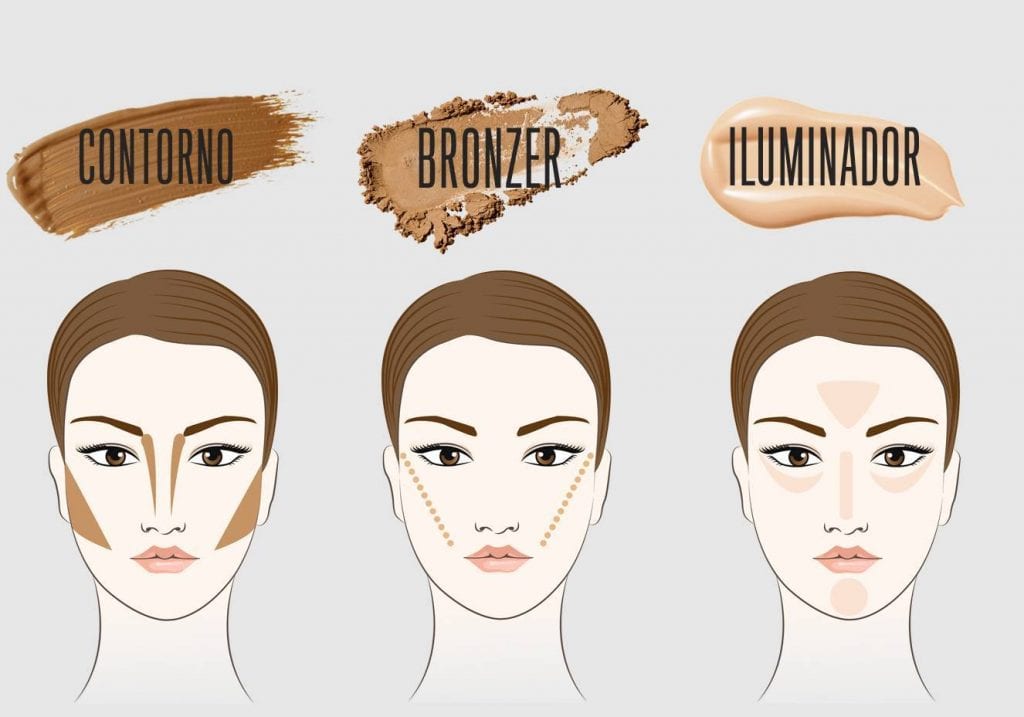
They are the easiest to contour. As they have completely rounded lines and are characterized, mainly by having the cheekbones subtly highlighted. Being wider than the forehead and jaw.
Here, just darken the lower part of your cheekbones and brighten the area below your eyes. Also illuminate the central axis of the face.
Colored concealer: find out what it is for and how to use each color
2. Oval Face
An oval face is characterized by balanced proportions, where the length of the face is longer than the width, and the forehead is slightly wider than the chin. Because this face shape is already well-proportioned, contouring is about enhancing the natural structure, not altering it too much.
How to Contour:
- Cheeks: Apply contour beneath your cheekbones to accentuate them, but don’t overdo it, as the oval shape already has a nice balance. Focus the contour slightly beneath the cheeks for a subtle lift.
- Jawline: Oval faces typically have a softer jawline, so a light contour along the jaw will help sharpen the shape and provide a more defined look.
- Forehead: If you have a large forehead, you can contour along the hairline to add balance. If you don’t, it’s best to skip this step.
- Nose: Light contouring along the sides of the nose can add definition without changing the overall shape of the face. Keep it subtle for a natural look.
Why it works: Oval faces already have balanced features, so contouring simply enhances the natural structure by adding definition and light. Avoid overcontouring to maintain the harmony of the shape.
3. Square Face
A square face has a strong jawline and equally wide forehead, cheekbones, and jaw. The goal with contouring a square face is to soften the angles and create a more rounded, feminine look.
How to Contour:
- Cheeks: Apply contour along the hollows of your cheeks and blend in a circular motion to soften the strong angles of your face.
- Jawline: Focus contouring along the sides of the jawline to make it appear more rounded. Avoid heavy contour directly on the jaw to prevent it from looking more square.
- Forehead: Contour the outer edges of your forehead to create a rounded appearance. Blend well into the temples for a softer, more oval shape.
- Nose: If you have a strong nose, apply contour along the sides of the nose to make it appear slimmer. Blend the contour to avoid harsh lines.
Why it works: Contouring with soft shadows and subtle highlights helps to round out the sharp angles of a square face, creating a more feminine and balanced appearance.
4. Heart-Shaped Face
A heart-shaped face has a wider forehead and cheekbones with a narrow chin. The aim with contouring a heart-shaped face is to bring balance to the proportions and add width to the chin, while emphasizing the natural high cheekbones.
How to Contour:
- Cheeks: Highlight the tops of your cheekbones to bring attention to them. Then, apply a contour beneath the cheekbones to add depth and definition.
- Jawline: Apply contour along the sides of the chin to create the illusion of a more balanced lower face.
- Forehead: Since heart-shaped faces often have a wider forehead, contour along the temples to add shadow and make the forehead appear more balanced.
- Nose: You can contour the sides of your nose to make it appear narrower and more defined. Highlight the center to create a balanced look.
Why it works: By contouring the forehead and chin, you bring balance to a heart-shaped face, creating a more symmetrical and proportional appearance.
5. Diamond-Shaped Face
A diamond-shaped face has narrow forehead and chin with wider cheekbones. The goal of contouring for a diamond face shape is to soften the cheekbones and draw attention to the eyes and jawline.
How to Contour:
- Cheeks: Contour under the cheekbones to reduce their prominence. You can also apply a little bit of highlight above the cheekbones to bring attention to your eyes and temples.
- Jawline: Contouring along the jawline can help define it further, but be careful not to overdo it. A light contour along the edges of the chin will help create a more balanced look.
- Forehead: If your forehead is narrower, you can contour the sides to add more width. Focus on blending well for a seamless finish.
- Nose: A light contour on the sides of the nose and a bit of highlight down the center will help create a balanced nose shape.
Why it works: Contouring a diamond face shape focuses on softening the angles while accentuating the eyes and jawline, creating a more harmonious and well-rounded look.
Contouring Tools You’ll Need
To contour like a pro, it’s important to have the right tools. Here are the essentials:
- Contour Palette: Choose a contour kit with a range of shades that suit your skin tone. A good palette will have a contour shade (cooler undertone) and a highlight shade (warmer undertone).
- Brushes: A contour brush with angled bristles is ideal for applying and blending contour to the hollows of your cheeks and jawline. A fan brush is great for applying highlighter to the tops of your cheekbones, nose, and forehead.
- Beauty Blender or Sponge: A sponge helps to blend contour and highlight seamlessly into the skin for a flawless finish.
Conclusion
Contouring can be a game-changer when it comes to enhancing your natural beauty and creating the appearance of a more sculpted face. By understanding your face shape and following the techniques that work best for you, you can achieve a polished, defined look that complements your features.
Remember, the goal of contouring is not to hide your face, but to enhance and define it. With practice, you’ll learn how to highlight your best features and create a look that’s uniquely yours. So, whether you have a round face, square jaw, or oval features, you can master the art of contouring and take your beauty routine to the next level!
FAQ – Frequently Asked Questions
1. How do I know which face shape I have?
To determine your face shape, look at the proportions of your forehead, cheekbones, and jawline. Use a mirror or take a selfie and trace the outline of your face to identify the shape. If your face is longer than wide, you likely have an oval or rectangular face. If your face is almost as wide as it is long, you may have a round, square, or diamond face.
2. Can I contour with powder if I have dry skin?
Yes! Powder contour is great, but if you have dry skin, be sure to prep your skin with a hydrating primer and moisturizer first. You can also opt for cream contour products, which tend to blend better on dry skin.
3. Should I contour every day?
Contouring is a personal choice. If you love the way it makes you feel and enhances your look, go for it! However, it’s not necessary to contour every day. On lighter makeup days, you can skip the contouring and focus on other features like brows and lashes.
4. Can I use the same contour technique for every face shape?
No, each face shape has unique contouring needs. The techniques should be customized for your specific face shape in order to enhance your features effectively.
5. How do I prevent my contour from looking too harsh?
To avoid harsh contour lines, blend, blend, blend! Use a damp beauty sponge or brush to soften the lines, and make sure you use the right contour shade for your skin tone. Always blend contour into the hairline and jawline for a seamless finish.

Sign up for our newsletter and stay up to date with exclusive news
that can transform your routine!
Warning: Undefined array key "title" in /home/storelat/public_html/wp-content/plugins/link-whisper-premium/templates/frontend/related-posts.php on line 12
Warning: Undefined array key "title_tag" in /home/storelat/public_html/wp-content/plugins/link-whisper-premium/templates/frontend/related-posts.php on line 13

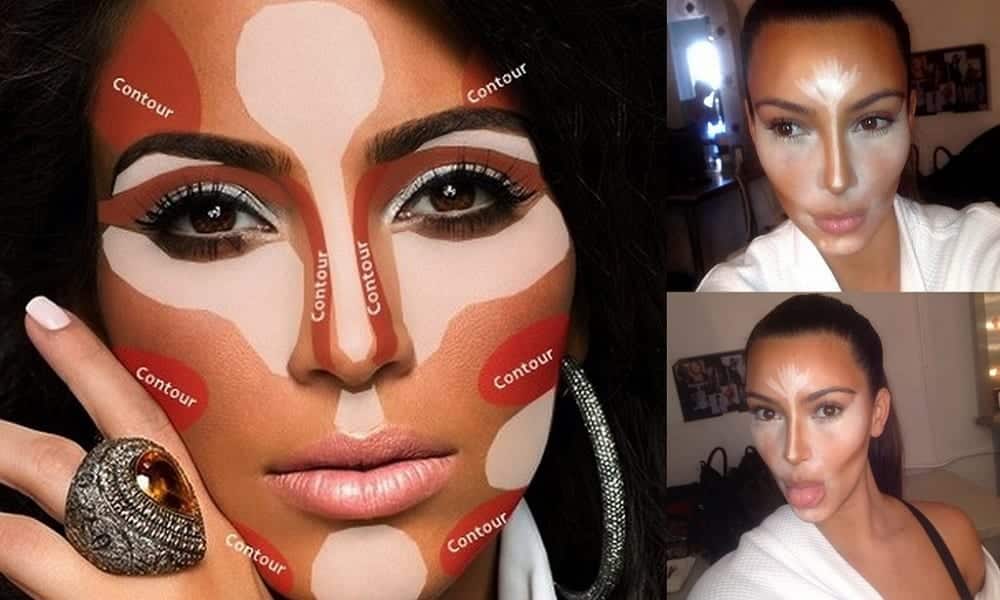

![O que é e como é feita a harmonização facial [estética]](https://storelatina.com/wp-content/uploads/2024/06/1718313613_What-is-facial-harmonization-aesthetics-and-how-is-it-done-305x207.jpg)
